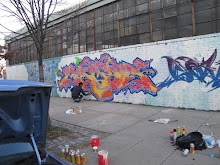Collective Memory and Image Dissemination: The Humane Empathic Connection Cut by the Disruption of History
The comments in this entry are based upon the article “The Great Atomic Film Cover-Up” by Greg Mitchell
"In the weeks following the atomic attacks on Japan 64 years ago, and then for decades afterward, the United States engaged in airtight suppression of all film shot in Hiroshima and Nagasaki after the bombings. This included footage shot by U.S. military crews and Japanese newsreel teams. In addition, for many years, many newspaper photographs were seized or prohibited."
How much of our perception of history is affected by the immediate media distribution and public reception of images of traumatic atrocities associated with warfare? If we do not see it, is it invisible to us? If we have no way to bear witness to the murder, annihilation, or criminal trespass that is inherent in war, do we lose the ability to act conscientiously and preventatively towards any future acts of military violence? Greg Mitchell’s article discusses the government suppression of images of the nuclear attack on Japan and the extenuating public ignorance and subsequent apathy that resulted from hiding this film footage. It must be the case that our decision-making process about warfare and violence is influenced but what we see, and feel about what we see.

Nations worldwide spent the last fifty years in an arms race, without judging the impacts of the last potent use of nuclear arms during the US attack on Japan, then public ignorance has been used to the advantage of maintaining the military complex. The visual image in media represents our historical reference to events. With the onset of photography in print material, then through television broadcast and film, we have learned about the world through the images broadcast about important events.
We formed opinions about and against Vietnam as a result of seeing ongoing images of war, and the human harm resulting for the Vietnamese and for U.S soldiers. We acted against racism in the south because of key images of Birmingham police officers assaulting children with dogs and high-pressure fire-hose water. We give support to famine victims in countries because we see the suffering hunger and lack of water cause for emaciated children in these situations. Social awareness of global issues is intricately intertwined with the forms in which the news and history is communicated abroad—the image jumpstarts the heart. Empathy is intimately connected to seeing, judging, and then acting on what we have seen.
“But suppressing film footage shot in Hiroshima and Na

gasaki was even more significant, as this country rushed into the nuclear age with its citizens having neither a true understanding of the effects of the bomb on human beings, nor why the atomic attacks drew condemnation around the world.”
We, as U.S. citizens, never learned to feel what had happened, to take true responsibility for these events, or to have the knowledge to change our perspective towards nuclear arms. For Lt. Col Daniel McGovern to say, “We didn’t want the material out because...we were sorry for our sins”, it is also indicative that the public community never even had the opportunity to assess the sins committed, let alone feel regret or sorrow for the attack. In our present day the US government has placed strict controls over the dissemination of images related to the dual invasions of Iraq, whether it is Iraqi civilians or US soldiers harmed by attacks. Our sense of empathy and compassion is short-circuited if we do not know what is actually happening during war.
The sad and horrific thing is that these images are purposefully withheld, so that we cannot have a holistic emotional response to the harms suffered. In regards to Hiroshima and Nagasaki our government used these weapons, and effectively disregarded the impact atomic warfare had on the Japanese, US soldiers, and subsequent descendants of those affected. We also never saw evidence to have an empathic basis for questioning the morality of nuclear warfare based on its true impacts when used.
Eirk Barnouw, “author of landmark histories of film and broadcasting” addresses this when he states…
“I feel that classifying all of this filmed material was a misuse of the secrecy system since none of it had had any military or national security aspect at all…the reason must have been—that if the public had seen it and Congressmen had seen it—it would have been much harder to appropriate money for more bombs.”
The empire of the United States is very much governed by its military complex, and the acts of the military are exempt from public review and discussion. The extenuating question is, once we realize this, are we as implicitly involved in the suppression of transformative action as those who control the dissemination of information? As educators it is vital for us to critically read the images in history texts, and to search out those that have never made it to the front page of newspapers, let alone into the pages of a traditional history textbook. The publication of an image should be taught as a political act itself, especially when the intentions may be to spread propaganda supporting warfare or to suppress information about the impacts of warfare.
One organization that serves as a great resource for educators addressing such issues is “Facing History, Facing Ourselves.” Another, World Can’t Wait, is a leader of political actions and protests against US militarization, whether through warfare, military recruiting, or challenging US leadership in its decisions on the wars in Iraq and Afghanistan. This article by Greg Mitchell makes the reader wonder how much of our society is run as a democracy or as benevolent despotism. Teachers are the advocates for our children’s sense of empathy and awareness…we must make more available to see, so that real consideration and informed social action on issues can be continually catalyzed.










0 Response to " "
Post a Comment